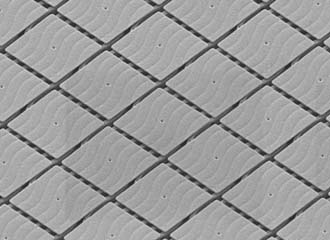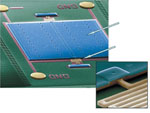Probing the Possibility of Power Over Force
 |
This image depicts an array of 3 micron (µm) x 3 µm mirrors separated by gaps of ~200 nanometers. At this distance, the Casimir force is not negligible, and it can influence the performance of the devices. |
Researchers from national laboratories and universities are working together through military funding in an attempt to control and even reverse a force that could lead to a whole new class of nanoelectromechanical systems. Known as the Casimir force, the focus of this research is a quantum mechanical force that has a strong modification effect on the behavior of nanometer-scale objects. It is responsible for the Casimir effect, which pushes two objects together when they are separated by a few nanometers. It also imposes boundary conditions on the electromagnetic waves existing in the free space around objects.
If tests prove that the force can be controlled, the outcome could alter the future of nanoelectromechanical systems (NEMS), drastically improving how they operate and enabling smaller devices. The force pushes together materials of such small sizes at such short distances that the idea of controlling it is still only theory as the scientists strive to discover if manipulation is even possible.
Daniel Lopez, a scientist at Argonne National Laboratory, the organization leading the research, explains that, “The introduction of closely spaced neutral objects in the infinite free space imposes limitations to the waves that can exist in the space between objects. Therefore, it becomes energetically convenient to reduce the distance between objects, and an attractive force appears between them. This force is known as Casimir force in honor of Hendrik Casimir, who proposed its existence in the 1940s.”
This means that when two objects are very, very close, the forces on the outside of those objects pushing them toward one another are greater than the forces between the two objects that push them away from one another. Hence, the two objects always come together. Lopez says researchers continue to argue about the origin of the force but explains that it is well accepted in the scientific community that it only comes into effect when objects come in very close contact, such as 100 to 200 nanometers apart. In this situation, the space between objects will influence the energy of the confined photons, causing an attraction between objects.
Lopez and his associates hope to prevent that from occurring and even cause a reversal. If they can, the impact on NEMS could be significant. According to the scientist, decades ago the Casimir force was a theoretical curiosity of quantum mechanics. It was predicted theoretically, but no one thought it could be seen. In the last 15 years or so, researchers have conducted experiments and precisely measured the force. Now, as the scientific community tries to reduce the size of mechanical devices to ever smaller dimensions, the effect of this force cannot be ignored. A complete understanding of and mechanisms to manipulate the force become increasingly important.
Currently, no mechanism exists that can control and manipulate the Casimir force either in a vacuum or in air, where most nanomechanical devices operate. Lopez explains that previous research suggests that manipulation will allow for the levitation of nanometer-scale devices. “If this becomes a reality, it would be possible to develop highly efficient mechanical systems capable of motion with almost no dissipation,” he says.
Though no one has demonstrated what
In addition to
The team of researchers began its effort in September 2009, and most of the work currently is focused on the fabrication of nanostructures and theoretical considerations. The team uses micromechanical force detectors to investigate. Ricardo Decca of Indiana University-Purdue University Indianapolis has a state-of-the-art experimental setup that allows the scientists to detect the force with a resolution close to fN (10-15 N). An fN is a Femto-Newton. “It is a very, very small force,” Lopez explains. The university has done the most precise measurement of the force.
To carry out their experiments, researchers have to fabricate metallic structures with dimensions close to 50 nanometers wide and 500 nanometers tall. “It is extremely challenging to fabricate these high aspect ratio structures using conventional nanofabrication processes,” Lopez explains.
 |
These microelectromechanical systems are used to detect the presence of the Casimir force. If scientists can control and reverse the force, it could have a major impact on nanoelectromechanical systems. |
In addition to the physical creations, the team also will work toward development of a theory that can calculate the Casimir force dependence on nanoscale structure and materials properties. The approach to controlling the force involves nanostructuring the interacting surfaces to tune its effects.
The results of all the work could influence an array of civilian and military applications. NEMS are used for a variety of purposes such as most car airbag systems, and they could be used to perform functions such as controlling light for communications. “There are thousands of examples,” Lopez adds. However, he continues, all those involve relatively large spaces such as 20 to 100 microns. If people want to reduce the space between the objects in the systems, they need a new mechanism to control those items in a reliable manner. That, Lopez shares, makes access to a new force important. If scientists can demonstrate control of and also reverse the Casimir force, they could levitate nanomaterials creating nanometer-size machines that will move with virtually zero friction, heat or dissipation. “Basically, you will be using your energy in an extremely efficient way,” Lopez says. This would enable new capabilities as well as manipulate nanometer-size objects.
The efficient systems could perform at very precise levels. The main problem to gaining control over the minuscule devices is that the smaller the size of an object, the more difficult it is to manipulate.
The Defense Advanced Research Projects Agency (DARPA) is funding this two-year research effort. According to the agency, scientists involved hope to develop a mechanism to control the Casimir force by using nanotechnology to manage the behavior of the waves that exist between closely spaced metallic objects.
Tom Kenny, the DARPA program manager for the Casimir Effect Enhancement (CEE) program, explains that his agency is interested in nanomechanical devices for sensing, communications and computation. “As these devices scale down to the nano regime, short-range forces such as Van Der Waals, Casimir and others can dominate, causing adhesion and failure, or create unique advantages for applications.” However, he adds, Casimir forces are not well understood. Scientists believe there are possibilities for tuning and even short-range repulsion.
Kenny states that as part of the goal of the project, the CEE plans to demonstrate dynamic control of the force including the ability to neutralize it. The effort is a one-phase, basic program. Success in the work will result in evidence that the Casimir force can be manipulated and that the manipulation is compatible with practical application in real devices. If success is determined, Kenny shares, a follow-on program may be funded to demonstrate use of the findings in a specific device or application.
For Lopez to declare success, the team will need to demonstrate a mechanism capable of manipulating the force. He adds that this is such a speculative, risky project that the agency wants to see if this research shows some evidence that scientists can achieve the repulsive Casimir force.
Kenny states that the agency is interested in developing devices and systems as well as identifying and providing new principles and concepts. He explains that the CEE is intended for basic, exploratory research of the fundamental concept and physics before the creation of a system or product.
Lopez says the work has progressed fine so far. “But we’re just starting,” he states. “When you’re just starting, it’s always OK.” The researchers are focusing on theoretical analysis formation of other groups, theoretical simulations and fabrication of structures. Progress is gradual. Once team members have a strong characterization of the force and a better idea of how it works, they will be able to focus more on modifying it.
WEB RESOURCES
Defense Advanced Research Projects Agency: http://www.darpa.mil




Comments